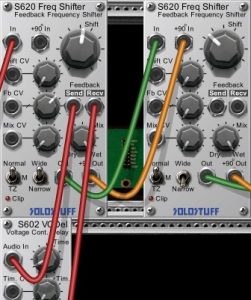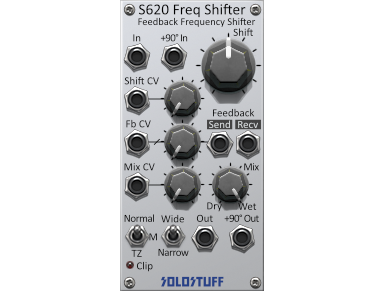Product Description
(This module is included in the System B)
Herald Bode and later Robert Moog has created the first analog frequency shifters in around 1964 and latter. Recent years along with the digital tide has shown a rise of a rather different shifter type called pitch shifters, which are now common on digital form for achieving auto tuning or playing samples.
The crucial difference between a pitch shifter and a frequency shifter is that a pitch shifter maintains the harmonic relation within the frequency components of a sound, thus the result stays in tune but is shifted by a musical pitch as if the same sound was played in that pitch. While a frequency shifter changes the harmonic relations, leading to none harmonic and hence completely different sounds, which is what the S620 is designed to do.
The SE620 features smooth manual shifting via it’s large shift knob as well as shift CV. The range of the shift can be controlled with the Wide/Narrow switch. Wide goes 16Khz up or down while narrow goes 1.5Khz up or down. Notice that you can exceed those limits with CV.
There are 3 modes of operation flipped with a switch. Normal, is strictly frequency shifting with no additional effects or artifacts. TZ (Through Zero) allows the harmonics to reflect back into audible range when they go bellow zero frequency (negative), the effect is mostly heard while DOWN shifting. M (Mirror) mode allows negative frequency harmonics to pass through zero and become audible positive frequency harmonics, the effect is mostly heard while UP shifting.
A feedback loop with insert effect patch points is also provided. This is where the power of frequency shifting gets multiplied. Try placing delay lines or an effect of your choice. The feedback knob controls the amount of the wet signal sent through the send patch point. When Fb CV is patched, the knob becomes an attenuator for it. Be careful here as this is an internal feedback loop so it can quickly overload the module if the insert effect is amplifying. Try lower feedback on the knob first then increase slowly. When the send/recv are not connected, send will be normaled to recv*.
beside the out patch point, there is a +90° out. This is a side effect of the complex math behind frequency shifting, It is the same as out but with every harmonic in the spectrum phase shifted by about 90°. Notice that the phase shifts here are not specific to a certain one frequency but relative to each harmonic frequency. The +90° out can be used for the following:
-As a spacializer to provide depth in stereo. Simply connect the out to say the left channel and the +90° out to the right channel and hear how it differs from the single out patched to both channels.

-Can be used to dramatically reduce the CPU usage of the S620 when connecting multiple shifters in a chain. This is done by connecting the +90° out to the +90° in of the next module in the chain. Check the patch shown on the right. This patching allows the second S620 to skip some of it’s internal CPU work. And it can give even different results when feedback is applied on the second module.
Finally a dry/wet mix knob/CV is provided.
Technical details
The S620 is particularly heavy on CPU. Oversampling will multiply the CPU usage of the S620 very rapidly. Because of this, the S620 does NOT support more than 8X (16X and above) oversampling. If you go higher, it will work but will start to loose base and allow some artifacts. We could have easily avoided this, but the demand on CPU above X8 is just not practical. Also, if you intend to purchase the module, make sure you test the S620 under several sampling rates in your DAW with and without oversampling, to make sure it fits your needs and run OK with your CPU.
*That is send will directly feed to recv.


Reviews
There are no reviews yet.